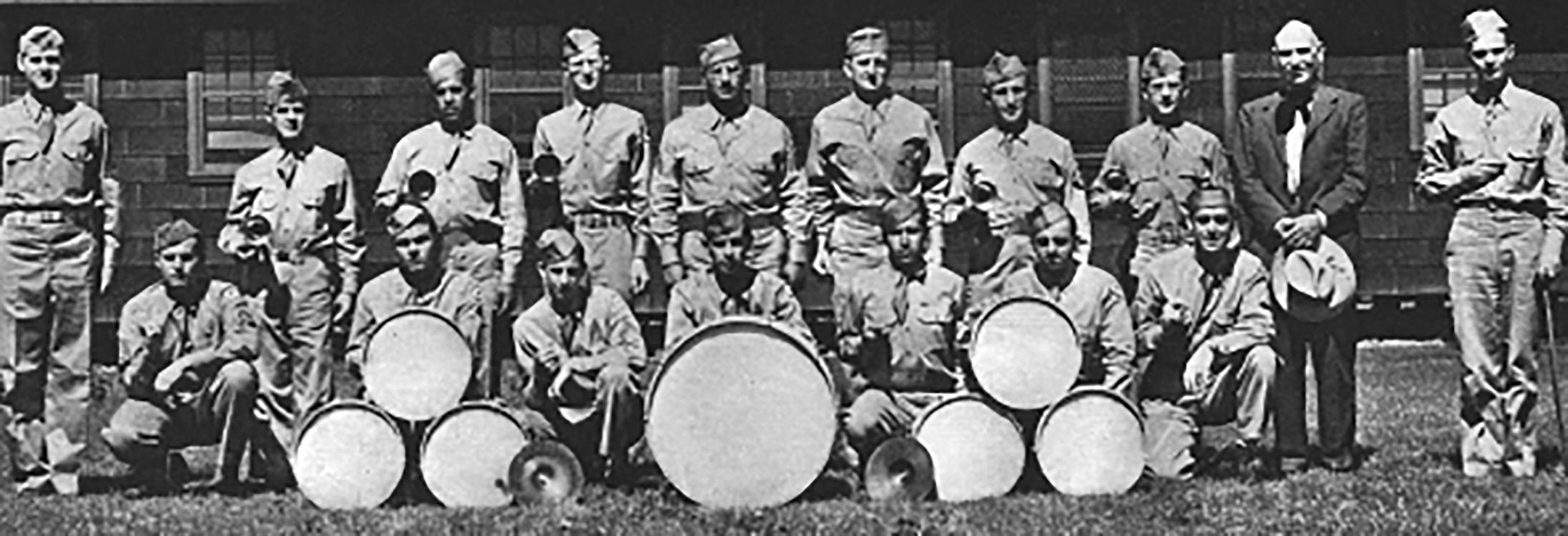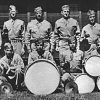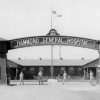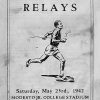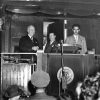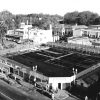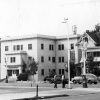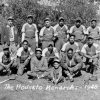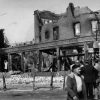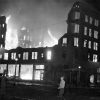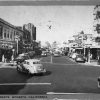The BigView
The 1940s were a decade of change in Modesto USA. As the depression of the 1930s slowly changed into a wartime America, Modesto would be home to one of the largest military hospitals, but underneath the war effort, Modesto survived the depression better than many other areas. Our agricultural economy really took hold, Gallo got bigger, other major food processors would get started and companies and co-ops like Tri Valley Growers would grow rapidly as major grocery chains developed in a post-war America and our region lead the way. Following the war, suburban neighborhoods would develop, Modesto would expand, and the availability of fuel, rubber for tires and a population at peace would experience new wealth, and freedom of time. This automotive freedom would lead to family vacations on the highways of the USA, the unique drive-ins became a staple of the open road and the teens of Modesto began to cruise and those drive-ins became a hangout. Cars were the new freedom of expression and popular culture would expand rapidly in art, music, architecture, food and more. Our friend Carl Baggese captures the spirit of the 1940s in Modesto. – Chris Murphy
The 1940s
By Carl Baggese
As the 1930s ended, the threat of war had escalated with Germany’s incursions into independent countries in Europe. The United States stayed neutral after the war began in Europe. December 8, 1940, U.S. Congress passed FDR’s Lend-Lease Act in March 1941. Military goods could now flow to Britain from the US without war being declared. On Dec. 7, 1941, war came to the United States as Japan, a German ally, bombing Pearl Harbor Hawaii, destroying most of the Pacific Fleet at anchor and killing over 2,000 sailors and military personnel. The next day, calling the Sunday sneak attack a “day that will live in infamy”. The US and the west coast were now at war.
Local Response to the War Effort
Much of this info was drawn from various issues of the Stanislaus Historical Quarterly by Robert LeRoy Santos. Copies are available at the Stanislaus Country Library.
The Modesto Bee reported on Dec. 8, 1941 that the Stanislaus County Civilian Defense Council had been activated and that the emergency machinery was functioning smoothly. The council had been created by an ordinance passed by county supervisors. Before Pearl Harbor protection was already in place, including “guards placed in strategic locations: water pumping stations, municipal airport, irrigation substations, communication centers, highway and railroad bridges, industrial plants, and Don Pedro Dam and Power Plant.”
In the midst of the new declaration of war, Modesto Mayor Carl Shannon issued a proclamation and a resolution was adopted by county supervisors “declaring a general emergency to exist, and calling upon people to compose their differences and to unite in an effort to beat Japan.”
Since the West Coast of the United States was more vulnerable to attacks from Japan, procedures for blackouts were put into place almost immediately. Modesto’s first blackout practice took place December 13, 1941, which lasted for 25 minutes, according to the Bee. Stanislaus County Defense Council praised Modestans highly for “their cooperation and the results obtained.” The blackout began at 8:30 p.m., taking five minutes for complete darkness to occur. Two residents refused to cooperate, and Modesto’s arch at Ninth and I streets remained lit longer than allowed.
Unfortunately, during the war, Japanese-American citizens, many of whom had lived here for years, were rounded up, their property confiscated, and herded into detention centers for the duration of the war. Locally Stanislaus and Merced county fairgrounds were used as assembly centers, which were staging sites before the evacuees were sent to relocation centers. Japanese living in Stanislaus and Merced counties were evacuated to the Merced County fairgrounds, or Merced Assembly Center, while those evacuated to Stanislaus County fairgrounds, or Turlock Assembly Center, came from northern California. (For a thorough study of the Japanese Evacuation, the Stanislaus Historical Quarterly has an online double-issue available at the Cal State Stanislaus Library website. The issue is the Fall-Winter 2009-2010 edition.)
On the Front Lines
The Modesto area was well-represented in the fighting forces of the United States. Recruitment efforts began almost immediately; volunteers were plentiful. Area men and women became pilots, sailors, infantry, WACS and WAVES. The stories of heroism included many from the area. Some were shot down over enemy territory, others spent time in enemy prison camps. Some lost their lives and others came home to heroes welcomes. Representative of those who served is the first area casualty as recorded in the Bee: The county’s first war casualty, as announced in the Bee on December 11, 1941, was Navy Coxswain J.B. Delane Miller, the son of Mr. and Mrs. E.F. Miller of south Modesto. The telegram read he “was lost in action in the performance of his duty and in the service of his country.” His brother Theo Miller coincidentally had been discharged from the Navy just two weeks prior.
Feeding the World
Sourced from the Modesto Bee, January 29, 1943
The canneries of Stanislaus County continued in 1942 to be one of the principal industries in the face of wartime restrictions. In the Modesto district, more than 5,400 persons were given employment, and the payrolls, while not definitely announced, were estimated to have approached $1.5 million for the year. One of the greatest changes of the past season was the increased number of women who have been employed in the packing houses. Jobs formerly believed the sole province of men have been filled by women. Food packed in this county has gone to the four points of the compass. Literally, from Greenland’s icy mountains to India’s coral shores have gone products this area processed to meet the call of the United States and the nations engaged with her in battle to put the ax to the Axis. Edited by RLS (from the Stanislaus Historical Quarterly)
Stanislaus County Military Facilities
During the war the Central Valley would house several new military facilities. Modesto would become the home of Hammond General Hospital and Riverbank would see over 300 acres turned into an aluminum manufacturing plant run by ALCOA and later Norris Industries. The aluminum plant was also known for manufacturing munitions during the Korean and Vietnam wars. During its early existence manufacturing aluminum for the war effort, it created a rift with farmers in the area who blamed the manufacturing plant for pollution that affected livestock.
Hammond General Hospital, the largest military hospital on the west coast was operational the year after Pearl Harbor. Named for Civil War General William Alexander Hammond, the 3,000-bed facility was located on Blue Gum Avenue and cost $1,750,000 to build 113 buildings. Meyers would employ 750 workers building barracks and wards, 25 by 150 feet in size, with three miles of covered walkways connecting the various buildings. With roads and utilities, the overall cost of Hammond would be $2,500,000. Over 24,000 injured soldiers were treated at the facility during World War II. After it closed in 1946, it became Modesto State Hospital, owned and run by the state of California, with its buildings used as a mental health facility.
(Delete this paragraph if room needed)
An additional wartime facility used well past the war years was the Crows Landing Naval Air Station. In late 1942 an 804-acre parcel of land was purchased for $86,708 and ground broken on December 1, 1942. The base was commissioned on May 25, 1943, as NAAF Crows Landing. Crows Landing’s isolated location prompted the Navy to run 10 liberty buses a day to Modesto and Patterson. Navy men were allowed to use the swimming pool at Patterson High School. In June 1945 the base accommodated 268 officers and 2116 men. By war’s end, the station was valued at $4 million. Crows Landing decommissioned July 6, 1946, becoming an OLF (Outlying Field) to Alameda and later Moffett Field. With the closing of Moffett, the Navy turned Crows Landing over to NASA’s Ames Research Center in 1993.
After the War
When the war ended and soldiers returned home, communities suddenly found themselves in the business of building home to accommodate growing families. As the baby boomer generation was born, there was a growing need for schools and all the infrastructure that communities would need for the population growth. Modesto was able to complete the LaLoma district which had been laid out with streets and trees planted, but no homes built before the war. Now expansion of the city would take hold and through the 1950s the city spread out in all directions for what was once a central core.
Loss of a Downtown Landmark
There was a time when Modesto had not one or two major hotels, but three (four if you count the older Tynan Hotel, later the State). In 1914, Modesto was big enough to support a residence hotel with a basement ballroom and all the fittings of the more elaborate hotels of bigger cities. Tinkham’s “History of Stanislaus County” discusses the Hotel Modesto in the section about its owner, Henry T. Crow:
“In 1911, Mr. Crow became associated with Oscar Hogin in the project of a first-class hotel for Modesto, and they bought the southwest corner of Eleventh and H streets, and in 1913 built a thoroughly modern and up-to-date hotel, a four-story building which was opened in June, 1914. They conducted the hotel under the firm name of Crow and Hogin, with a manager, and except for two years when Mr. Hogin managed it alone, Mr. Crow has been interested in running the hotel. On January 1, 1920, Mr. Crow bought out the interest of Mr. Hogin. Assisted by his wife and family, he employs thirty-three people.
Mr. Crow has enlarged the Hotel Modesto from a four-story to a five-story building. The structure is built of brick, 100×140 feet in dimension, with a concrete basement and an asbestos roof. Hot and cold water are to be had throughout the building, as well as steam heat and electric light, and the 142 guest rooms will easily make it the largest, as it is the finest appointed, hostelry in this part of the state.” (From the Historic Modesto website, by Carl Baggese)
The Hotel Modesto became the center of social activity in a growing community. It would be followed in short order by the Hotel Hughson, with a swimming pool in the basement and a roof garden; and the Hotel Covell, which boasted the National Theatre, a movie house, as part of the structure. An expansion in 1921, added a fifth floor and an additional wing of rooms was constructed in the late 1920s. Hotel Modesto remained the choice of many of Modesto’s important people, with some living in the hotel, as well as conducting business in its plush public rooms.
Fire destroyed the hotel on May 2, 1944. The fire started in the basement of the Dutch Boy Paint Store and soon swept the hotel. Two people were killed, both as they were making attempts to escape with the help of firefighters. Crowds of people came out to watch firefighters try to control the blaze. In the end, the older section of the hotel was completely destroyed.
The ruins of the hotel were fenced in and remained an eyesore in downtown Modesto until 1958 when the location was cleared for Modesto’s new city hall opening in1960. Because the basement had caved in, and the lot was already excavated for a lower level, the new city hall featured a below level courtyard with attractive landscaping still visible today. The city hall building would become a court building for Stanislaus County and a new city-county building has been built on the site of the Hotel Hughson and Hotel Covell.
Modesto – The Modest City
(Excerpted from a packet of 1940s postcards)
* Strange as it may seem there is one city in California which takes its name from the modesty of its pioneers and the people of Modesto have tried to live up to the reputation ever since.
* Modesto today is famed for several things in addition to its arched sign which proclaims, “Water, Wealth, Contentment, Health” to the world. For instance, the city has the national record for highest per capita retail trade for cities above 10,000 population . . .
* It boasts of a championship band that has won the State championship five years in a row and the second place in the national contests twice. The city has a full symphony orchestra of 80 pieces.
* No financial institutions failed in the city during the depression and the business failures amounted to less than one percent.
* There is a Junior College with close to 1000 students registered which turned out a conference championship football team last year.
* The City developed last year the finest water recreational area to be found in any city in the Valley by placing a weir dam and backing up the waters of the Tuolumne River for five miles. Thousands of people now boat and swim in the lake created and picnic in Legion Park on the banks of the lake.
* Municipal improvements acquired last year were an 80 acre aviation field with hangar, a baseball park and bleachers that are the envy of the Coast League and a municipal golf course.
* Modesto doesn’t brag much but has been doing things.
* Industrial plants ran full blast this year putting fruit, vegetables and dairy products into packages and cans and their product was snapped up by the trade before it could go into a warehouse. Every industrial plant in Modesto fills a definite need and is processing some raw product of the surrounding area.


